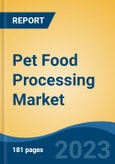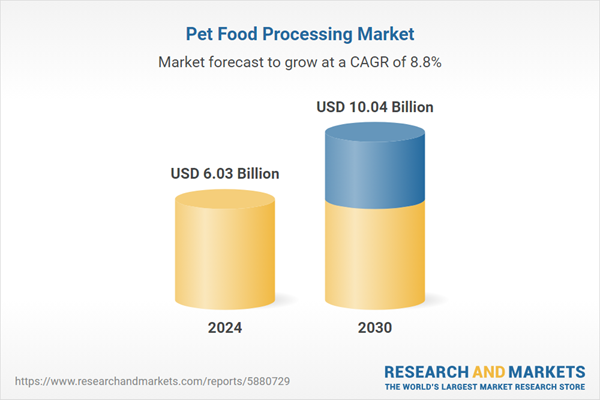Speak directly to the analyst to clarify any post sales queries you may have.
10% Free customizationThis report comes with 10% free customization, enabling you to add data that meets your specific business needs.
The rising trend of pet humanization is one of the key drivers of the global pet food processing market. Pet owners today are increasingly treating their pets as family members and are therefore more willing to invest in premium, nutritious, and functional food options. This has led to a surge in demand for specialized pet food products like grain-free, organic, high-protein, and breed-specific formulations. As a result, manufacturers are adopting advanced processing technologies such as extrusion, drying, and coating to enhance product quality, palatability, shelf-life, and nutritional value, thereby fostering innovation in the pet food processing landscape.
Key Market Drivers
Rising Trend of Pet Adoption
Pet ownership continues to rise globally, driven by shifting attitudes that increasingly view pets as family members rather than just companions. In 2024, approximately 38% of households in major urban regions of China reported owning at least one dog or cat, up from 30% in 2022. In parallel, U.S. surveys indicated that nearly 70% of millennials adopted plant-forward lifestyles and also owned pets, reflecting an emotional connection that’s reshaping purchasing behavior. This deeper bond is boosting demand for high-quality, human-grade pet foods mirroring human nutrition trends.Urbanization and busier lifestyles are further amplifying the demand for convenient, ready-to-feed pet food options. In 2023, almost 45% of global pet owners cited time constraints as their primary reason for choosing kibble or pre prepared meals. Busy professionals are increasingly seeking nutritious, premium pet foods that simplify feeding routines. As a result, manufacturers are innovating in formats like single-serve pouches, nutritionally complete meal packs, and nutraceutical-enriched treats that fit seamlessly into fast-paced urban lifestyles.
Rising prestige and emotional value associated with pet ownership in emerging markets like China and India is also a key driver. In 2024, nearly 22% of Chinese households reported pet ownership as a status symbol, prompting greater investment in specialty food products. Pet owners are now demanding advanced nutrition - customized for life stage, breed, or dietary sensitivity - and are gravitating toward premium, functional pet food options that offer clean-label transparency and enhanced palatability.
This humanization trend is spurring demand for premium, diversified pet food offerings across formats and nutrition. Consumers expect products aligned with human food trends: grain-free, organic, high-protein, hypoallergenic options, and functional ingredients like probiotics or omega 3s. With higher disposable incomes, pet parents are investing in tailored formulations that address weight control, joint health, or digestive wellness. This nuanced demand is prompting food processors to enhance texture, flavor, ingredient quality, and packaging innovation, fueling growth across the pet food processing landscape.
Key Market Challenges
Changing Prices of Raw Material
Fluctuations in raw material prices can lead to several challenges and uncertainties that affect both pet food manufacturers and consumers. Increases in the prices of key raw materials, such as meat, grains, and vegetables, can lead to higher production costs for pet food manufacturers. This cost pressure may limit their ability to maintain competitive pricing for their products, potentially leading to reduced profit margins or the need to raise product prices. Rapid and unexpected changes in raw material prices can disrupt the supply chain.Manufacturers may face challenges in securing a consistent and cost-effective supply of ingredients, leading to potential production delays and shortages. To manage costs, manufacturers may need to alter the formulation of their pet food products, potentially affecting the quality, nutritional content, or palatability of the final product. This can impact consumer preferences and loyalty. In a competitive market, manufacturers may hesitate to pass on the full extent of raw material price increases to consumers, leading to tighter profit margins and increased competition for market share.
Key Market Trends
Improved Equipment and Technologies
Enhanced equipment and advanced technologies are creating lucrative opportunities for the global pet food processing market to flourish. Manufacturers are increasingly focusing on improving and upgrading manufacturing technologies to cater to the dietary needs of domestic animals. Implementation of pet food extruder maintenance not only saves manufacturers time and money but also ensures the quality of pet food for cats and dogs while optimizing the lifespan and efficiency of the machinery. By embracing advanced technologies and equipment, manufacturers can enhance the quality and performance of their products, thereby meeting the overall customer requirements.Key Market Players
- Andritz Group
- Buhler Holding AG
- Clextral SAS
- Coperion GMBH
- F.N. Smith Corporation
- Mepaco Group
- Precision Food Innovations
- Reading Bakery Systems
- GEA Group Aktiengesellschaft
- The Middleby Corporation
Report Scope:
In this report, the Global Pet Food Processing Market has been segmented into the following categories, in addition to the industry trends which have also been detailed below:Pet Food Processing Market, By Equipment Type:
- Mixing & Blending Equipment
- Forming Equipment
- Baking & Drying Equipment
- Others
Pet Food Processing Market, By Animal Type:
- Dog
- Cat
- Others
Pet Food Processing Market, By Form:
- Dry
- Wet
Pet Food Processing Market, By Region:
- North America
- United States
- Canada
- Mexico
- Europe
- France
- United Kingdom
- Italy
- Germany
- Spain
- Asia-Pacific
- China
- India
- Japan
- Australia
- South Korea
- South America
- Brazil
- Argentina
- Colombia
- Middle East & Africa
- South Africa
- Saudi Arabia
- UAE
Competitive Landscape
Company Profiles: Detailed analysis of the major companies present in the Global Pet Food Processing Market.Available Customizations:
With the given market data, the publisher offers customizations according to a company's specific needs. The following customization options are available for the report.Company Information
- Detailed analysis and profiling of additional market players (up to five).
Table of Contents
Companies Mentioned
- Andritz Group
- Buhler Holding AG
- Clextral SAS
- Coperion GMBH
- F.N. Smith Corporation
- Mepaco Group
- Precision Food Innovations
- Reading Bakery Systems
- GEA Group Aktiengesellschaft
- The Middleby Corporation
Table Information
| Report Attribute | Details |
|---|---|
| No. of Pages | 180 |
| Published | August 2025 |
| Forecast Period | 2024 - 2030 |
| Estimated Market Value ( USD | $ 6.03 Billion |
| Forecasted Market Value ( USD | $ 10.04 Billion |
| Compound Annual Growth Rate | 8.8% |
| Regions Covered | Global |
| No. of Companies Mentioned | 10 |









